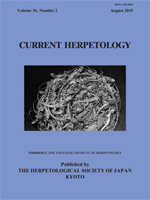A non-native insectivorous lizard, the green anole (Anolis carolinensis), is causing a severe negative impact on the insect fauna of the Ogasawara Islands of Japan, a UNESCO World Natural Heritage site. A common method to capture anoles is to use adhesive traps. We tested if attracting the lizard by bait improves the effectiveness of these traps. We examined the effects of a lizard's (1) length of fasting period, (2) distance to the bait, and (3) access to the bait on feeding attempts in a laboratory experiment using 15 lizards collected from Chichi-jima Island. Responses to the baits were also observed in the field, and stomach contents of the trapped lizards were analyzed to assess fasting level in a natural population. The number of lizards that reached the bait was positively correlated with increased fasting days. With a smaller number of days of fasting, the number of lizards that reached the bait was significantly higher when the bait was 50 cm away than 195 cm. Based on the stomach contents of wild A. carolinensis on Chichi-jima, the fasting period of invasive A. carolinensis was typically short, with 92% of the lizards foraging at least every other day. Both laboratory and field experiments indicate the bait must be less than ca. 2 m away to effectively attract the lizard. There is no clear difference between a lizard's attraction to crickets tethered to a line and those housed in a transparent cup. Therefore, whether the lizard could physically capture the prey did not alter the effectiveness of the bait. This suggests that using an artificial bait simulating prey movement may also be effective.
BioOne.org will be down briefly for maintenance on 12 February 2025 between 18:00-21:00 Pacific Time US. We apologize for any inconvenience.
How to translate text using browser tools
1 August 2015
Feasibility of Bait Attraction in the Green Anole (Anolis carolinensis)
Naho Mitani,
Kazuma Anyoji,
Yasutaka Uzuki,
Kohta Taga
ACCESS THE FULL ARTICLE

Current Herpetology
Vol. 34 • No. 2
August 2015
Vol. 34 • No. 2
August 2015
Anolis carolinensis
Bait distance
Fasting days
invasive species
Tangibility




